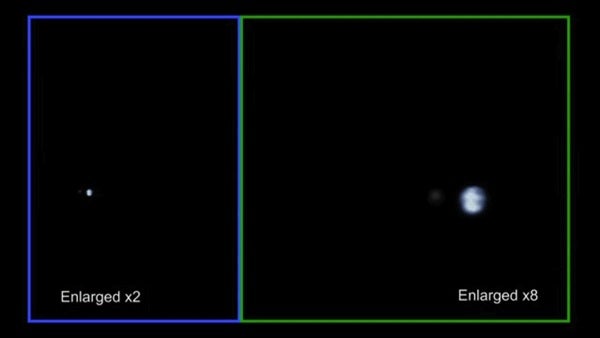“If Captain Kirk of the USS Enterprise said, ‘Take us home, Scotty,’ this is what the crew would see,” said Scott Bolton from the Southwest Research Institute in San Antonio. “In the movie, you ride aboard Juno as it approaches Earth and then soars off into the blackness of space. No previous view of our world has ever captured the heavenly waltz of Earth and Moon.”
The cameras that took the images for the movie are located near the pointed tip of one of the spacecraft’s three solar-array arms. They are part of Juno’s Magnetic Field Investigation (MAG) and are normally used to determine the orientation of the magnetic sensors. These cameras look away from the sunlit side of the solar array, so as the spacecraft approached the system’s four cameras pointed toward Earth. Earth and the Moon came into view when Juno was about 600,000 miles (966,000km) away — about three times the Earth-Moon distance.
During the flyby, timing was everything. Juno was traveling about twice as fast as a typical satellite, and the spacecraft itself was spinning at 2 rpm. To assemble a movie that wouldn’t make viewers dizzy, the star tracker had to capture a frame each time the camera was facing Earth at exactly the right instant. The frames were sent to Earth where they were processed into video format.
“Everything we humans are and everything we do is represented in that view,” said the star tracker’s designer, John Jørgensen of the Danish Technical University near Copenhagen.
Also during the flyby, Juno’s Waves instrument, which is tasked with measuring radio and plasma waves in Jupiter’s magnetosphere, recorded amateur radio signals. This was part of a public outreach effort involving ham radio operators from around the world. They were invited to say “HI” to Juno by coordinating radio transmissions that carried the same Morse-coded message. Operators from every continent, including Antarctica, participated.
“With the Earth flyby completed, Juno is now on course for arrival at Jupiter on July 4, 2016,” said Rick Nybakken from NASA’s Jet Propulsion Laboratory in Pasadena, California.
The Juno spacecraft was launched from Kennedy Space Center in Florida on August 5, 2011. Juno’s launch vehicle was capable of giving the spacecraft only enough energy to reach the asteroid belt, at which point the Sun’s gravity pulled it back toward the inner solar system. Mission planners designed the swing by Earth as a gravity assist to increase the spacecraft’s speed relative to the Sun so that it could reach Jupiter. (The spacecraft’s speed relative to Earth before and after the flyby is unchanged.)
After Juno arrives and enters into orbit around Jupiter in 2016, the spacecraft will circle the planet 33 times, from pole to pole, and use its collection of science instruments to probe beneath the gas giant’s obscuring cloud cover. Scientists will learn about Jupiter’s origins, internal structure, atmosphere, and magnetosphere.










